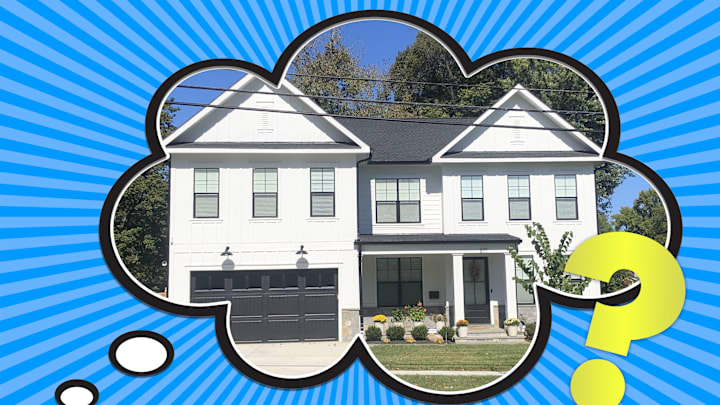Drive down any residential street in an affluent American suburb and you’re likely to find shiny new homes replacing 20th-century abodes. But many of these new houses aren’t built in local styles to reflect the character of the neighborhood or town. They’re so-called minimalist modern farmhouses, painted white, with black roofs, window frames, and railings, seemingly adrift from architectural context. Where did the big black-and-white look come from, and why is it so popular?
Minimalist Mansions
American homes have changed drastically over the past 150 years. In the late 19th century, many well-to-do families lived in Victorian-style mansions that were vaguely inspired by buildings in urban Britain, or Neoclassical homes modeled on the structures of ancient Greece and Rome. In the 1910s and 1920s, architect Frank Lloyd Wright popularized the Prairie School style, designing middle-class homes with organic materials and open, horizontally oriented plans. The Minimal Traditional, Cape Cod, and Ranch styles, which emerged after the Great Depression and remained popular well into the 1970s, answered the need for cost-effective, affordable housing for working- and middle-class families.

Today, a large number of new American homes fall into a category that journalist Dan Kois has referred to as “Great White Houses,” or GWHs; others call them minimalist modern farmhouses with contemporary touches. True to their name, Great White Houses stand out for their large size (the one constructed next to Kois’s own home boasted 5600 square feet of space, significantly more than the current average) and monotonous color schemes, which tends to go for an all-white paint job with deep black accents. GWHs can be found throughout the country and particularly in well-to-do neighborhoods with lots of teardowns, or properties where the value of the land exceeds that of the structure that’s built on it.
Let’s look at where this style originally came from—and how did it manage to take over suburban landscapes so suddenly and thoroughly.
You May Also Like:
- Why So Many Old British Homes Have Bricked-Up Windows
- What People In the '50s and '60s Thought Houses Would Look Like in 1986
- The Joys (and Unexpected Perils) of Sleeping in a Tiny House
Add Mental Floss as a preferred news source!
Blame the Gaineses
Most experts on the subject trace the origins of Great White Houses to the home improvement show Fixer Upper. Launched in 2014 on HGTV, it starred Chip and Joanna Gaines, a married contractor-designer couple who specialized in renovating houses in Waco, Texas. Their style blended a traditional, cozy aesthetic with contemporary preferences for big, open floorplans, neutral colors, and multiple spaces for entertaining. The combination of old and new, rustic and modern, proved so popular with viewers that it started to leave a noticeable effect on the housing market. As demand for so-called “modern farmhouses” rose, so did supply.
But, while the modern farmhouses featured on Fixer Upper had unique exteriors and interiors that spoke to both the history of the structures and the personalities of the people living in them, today’s big black-and-white houses tend to be more streamlined and, by extension, far less idiosyncratic.
To some extent, this trend can be attributed to the preferences of homeowners. Minimalism as a style of both architecture and interior design, defined in ELLE Decor as its “clean lines, simplicity, and uncluttered spaces,” has been in vogue for several decades. Minimalist homes are cheap to furnish and easy to clean. At the same time, their aesthetics exude a sense of timelessness, tranquility, and classiness—qualities that appeal to homeowners and buyers of various age groups and income levels.
The Black-and-White Blueprint
The appearance of the Great White House has also been shaped by economics. A big, generic home, with zero personal touches, will appeal to the widest swath of prospective owners. As one expert told Kois, “You never would make a house yellow, because you’d lose three buyers who don’t like yellow.”

The dynamics of America’s housing market also help explain both the size and appearance of these homes. As the value of land increases, it makes less sense to maintain an old, outdated home on it. Across America’s suburbs, owners are selling their small “starter” homes to developers, who promptly tear them down to build the biggest and most sellable house possible on the property in order to recoup their investment. This line of reasoning explains why the black-and-white blueprint has superseded classic architectural styles as of late.
But just because the Great White House is all over the place right now doesn’t mean it’s here to stay. Already, new iterations of the modern farmhouse are emerging. The black-and-white look might be on the cusp of getting replaced by warm minimalism, a style that involves a wider variety of colors and textures.
